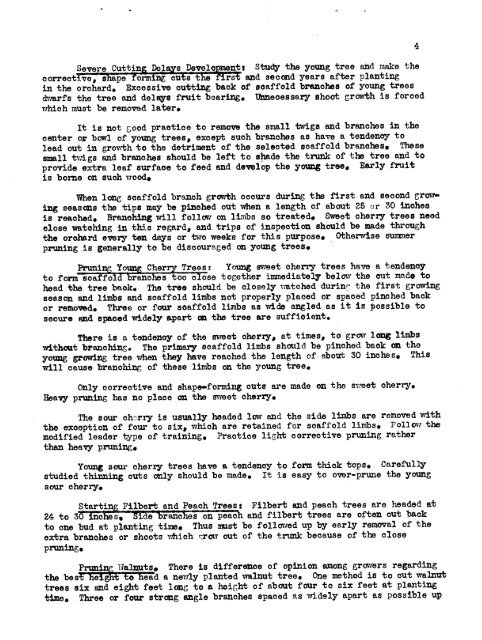Pruning suggestions for fruit trees.pdf
Pruning suggestions for fruit trees.pdf
Pruning suggestions for fruit trees.pdf
You also want an ePaper? Increase the reach of your titles
YUMPU automatically turns print PDFs into web optimized ePapers that Google loves.
Severe Cutting Delays Develoient: Study the young tree and make the<br />
correotio Shpe ormtng outs the flr and seocnd years after planting<br />
in the orohard. Excessive cutting back of søaffold branches of young <strong>trees</strong><br />
dwarfs the tree and delays <strong>fruit</strong> bearing. Unnecessary shoat growth is <strong>for</strong>ced<br />
which must b removed later.<br />
It is not good practice to remove the small twigs and branches in the<br />
oenter or bowl of young <strong>trees</strong> except suoh branches as have a tendency to<br />
lead out in grouth to the detriment of the sOleoted scaffold branches. These<br />
small twigs end branches should be left to shade the trunk of the tree and to<br />
provide extra leaf surface to feed and develop the young tree, Early <strong>fruit</strong><br />
is borue on such wood,<br />
Then long scaffold branch growth occurs during the first and second grow<br />
ing seasons the tips may be pinched out when a length of about 25 or 30 inches<br />
is reached. Branching wi].l follow on limbs so treated. Sweet cherry <strong>trees</strong> need<br />
close watching in this regard, and trips of inspection should be made through<br />
the orchard c-very ten days or two weok <strong>for</strong> this purpose. Otherwise summer<br />
pruning is generally to be discouraged on young <strong>trees</strong>.<br />
<strong>Pruning</strong> You Cherry Trees: Young svet cherry <strong>trees</strong> have a tendency<br />
to <strong>for</strong>m soafoldranohes toO close together immediately below the out made to<br />
head the tree back. The tree should be closely watched durinr, the first growing<br />
season and limbs and scaffold limbs not properly placed or spaced pinched back<br />
or removed. Three or four scaffold limbs as wide angled as it is possible to<br />
secure end spaced widely apart on the tree are sufficient.<br />
There is a tendency of the sweet cherry, at times, to grow long liiüba<br />
without branching. The primary scaffold limbs should be pinched baek on the<br />
young growing tree when they have reached the length of about 30 inches. This<br />
Will osuse branching of these limbs on the young tree.<br />
Only corrective and shape..<strong>for</strong>ming outs are made on the sweet cherry.<br />
Ieawy pruning has no place on the sweet cherry.<br />
The sour ch-'rry is usually headed low and the side limbs are removed with<br />
the exception of four to six, which are retained <strong>for</strong> scaffold limbs. Follow the<br />
modified leader typo of training. Practice light corrective pruning rather<br />
than heavy pruning.<br />
Young sour cherry <strong>trees</strong> have a tendency to <strong>for</strong>m thick tops. Carefully<br />
studied thinning cuts only should be made, It is easy to over-prune the young<br />
sour cherry.<br />
Starting Filbert and Peach Trees: Filbert and peach <strong>trees</strong> are headed at<br />
24 to 30 incs, S1de brano onjach and filbert <strong>trees</strong> are often out back<br />
to one bud at planting time, Thus must be followed up by early removal of the<br />
extra branches or shoots which prow out of the trunk because of the close<br />
pruning,<br />
<strong>Pruning</strong> Walnuts., There is difference of opinion among growers regarding<br />
the best height tO head a newly planted walnut tree. One method is to out walnut<br />
<strong>trees</strong> SIX and eight feet long to a height of about four to six feet at planting<br />
time, Three or four strong angle branches spaced as widely apart as possible up<br />
4
















